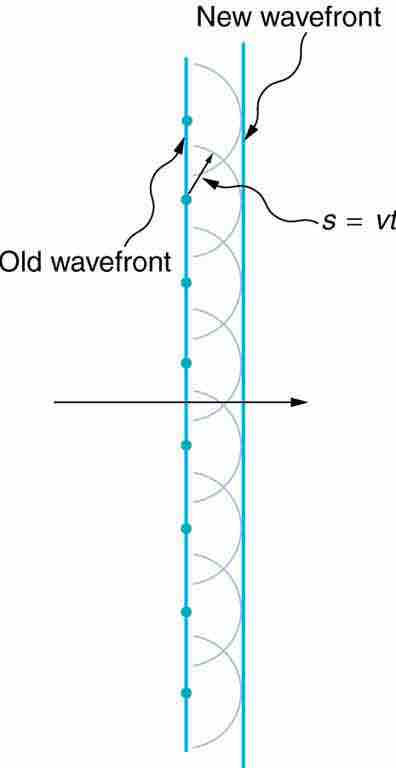Overview
The Huygens-Fresnel principle states that every point on a wavefront is a source of wavelets. These wavelets spread out in the forward direction, at the same speed as the source wave. The new wavefront is a line tangent to all of the wavelets.
Background
Christiaan Huygens was a Dutch scientist who developed a useful technique for determining how and where waves propagate. In 1678, he proposed that every point that a luminous disturbance touches becomes itself a source of a spherical wave. The sum of the secondary waves (waves that are a result of the disturbance) determines the form of the new wave. shows secondary waves traveling forward from their point of origin. He was able to come up with an explanation of the linear and spherical wave propagation, and derive the laws of reflection and refraction (covered in previous atoms) using this principle. He could not, however, explain what is commonly known as diffraction effects. Diffraction effects are the deviations from rectilinear propagation that occurs when light encounters edges, screens and apertures. These effects were explained in 1816 by French physicist Augustin-Jean Fresnel.

Straight Wavefront
Huygens's principle applied to a straight wavefront. Each point on the wavefront emits a semicircular wavelet that moves a distance s=vt. The new wavefront is a line tangent to the wavelets.
Huygens's Principle
Figure 1 shows a simple example of the Huygens's Principle of diffraction. The principle can be shown with the equation below:
where s is the distance, v is the propagation speed, and t is time.
Each point on the wavefront emits a wave at speed, v. The emitted waves are semicircular, and occur at t, time later. The new wavefront is tangent to the wavelets. This principle works for all wave types, not just light waves. The principle is helpful in describing reflection, refraction and interference. shows visually how Huygens's Principle can be used to explain reflection, and shows how it can be applied to refraction.

Huygens's Refraction
Huygens's principle applied to a straight wavefront traveling from one medium to another where its speed is less. The ray bends toward the perpendicular, since the wavelets have a lower speed in the second medium.

Reflection
Huygens's principle applied to a straight wavefront striking a mirror. The wavelets shown were emitted as each point on the wavefront struck the mirror. The tangent to these wavelets shows that the new wavefront has been reflected at an angle equal to the incident angle. The direction of propagation is perpendicular to the wavefront, as shown by the downward-pointing arrows.
Examples
This principle is actually something you have seen or experienced often, but just don't realize. Although this principle applies to all types of waves, it is easier to explain using sound waves, since sound waves have longer wavelengths. If someone is playing music in their room, with the door closed, you might not be able to hear it while walking past the room. However, if that person where to open their door while playing music, you could hear it not only when directly in front of the door opening, but also on a considerable distance down the hall to either side. is a direct effect of diffraction. When light passes through much smaller openings, called slits, Huygens's principle shows that light bends similar to the way sound does, just on a much smaller scale. We will examine in later atoms single slit diffraction and double slit diffraction, but for now it is just important that we understand the basic concept of diffraction.
Diffraction
As we explained in the previous paragraph, diffraction is defined as the bending of a wave around the edges of an opening or an obstacle.